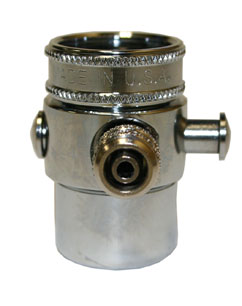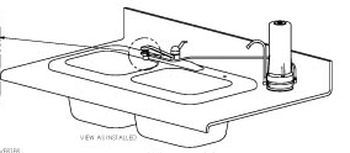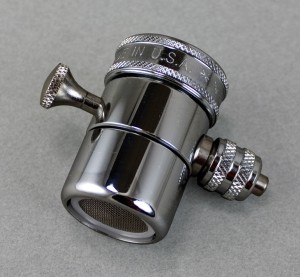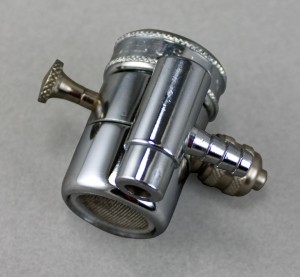Pure Water Annie’s FAQ Series
Pure Water Gazette Technical Wizard Pure Water Annie Answers All the Persistent Questions about Water Treatment.
This week’s topic: Faucet Diverter Valves.
What are diverter valves used for?
The main use in water treatment is to change the direction of flowing water–to send a water stream a in a different direction for a purpose. The most common usage is with countertop water filters, where the valve is used to divert the stream of water flowing into the sink so that it flows instead through the water filter.
The countertop filter sits beside the sink and gets its water from the diverter valve attached to the sink faucet. It’s circled in the picture.
Are there different kinds of valves?
Yes, the most standard is the type that diverts water running from the sink faucet through a single tube to the water filter. Another style, called a “return” diverter, diverts water to the filter, then dispenses the filtered water that has been returned to the valve through a separate tube. With the standard diverter water is dispensed through a spout on the water filter itself. With the return style, a double hose assembly is needed, but there is no dispensing spout.
Standard diverter valve. Tube that sends water to the filter is attached with the compression fitting on the right. (Cheaper valves often use “barbed” connectors to which the tube is pushed on.) Pulling the knob on the left sends water to the water filter and the knob springs back to “off” position when the sink water is turned off.
“Return” diverter valve sends water to the filter exactly like the standard model, but filtered water is returned through a second hose to the small spout attached to the side of the valve. The return hose attaches to the barbed connector in the picture.
What causes diverter valves to fail?
The most usual cause is calcium scale buid-up on the spring and other inner parts.
How do you fix a diverter valve if the knob sticks open and the spring fails to turn it off?
Suggested methods (sometimes they work, sometimes they don’t) include soaking the entire valve in a weak acid like vinegar to dissolve the calcium buid-up on the spring, using a chemical descaler like LimeOut, or removing the valve from the sink faucet and dropping a couple of drops of vegetable oil into the small hole in the top of the valve where water enters the valve from the faucet. One of the best ways is to simply ignore the problem. You’ll find that manually turning off the water with a push of the finger really isn’t a big deal. Or, you can replace the valve with another like it (Pure Water Products offers lifetime parts replacement on its countertop filters), or, you can replace the standard valve with a springless model that requires pushing for both on and off, as we’ve always done with light switches. A springless, toggle-style diverter is shown below.

This diverter has no spring, and if you’re up to this much exercise, you can push the plunger one way to turn the valve on and then push from the other side to turn it off.
Which is better, the “compression” diverter valves pictured on this page or the conventional diverters that are attached with a barbed fitting and in some models even clamped on with a machine so they can’t be removed?
Since this is a part that, no matter how good it is, almost never lasts as long as the rest of the water filter, it’s obvious that being able to replace it easily is a big advantage. With some countertops, the entire hose assembly has to be changed in order to replace the diverter valve.
I tried but can’t put the hose on a new barbed style diverter that I bought. How do you do it?
The best way is to soak the tubing in fairly warm water for a few minutes. This will usually expand the tubing and allow you to push it onto the barb. When it cools, the barb will hold it tight.




![pwanniemedium[1]](http://www.purewatergazette.net/blog/wp-content/uploads/2012/05/pwanniemedium1-246x300.jpg)



